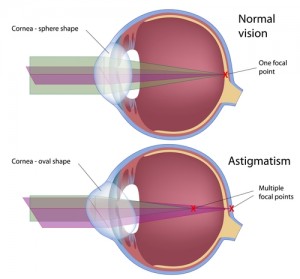What Is Astigmatism?
 Having clear eyesight is important for nearly every daily task, and experiencing even moderately blurry vision can dramatically impair your ability to function well at work and recreation. Astigmatism is one of the most common conditions that can adversely affect eyesight. Left untreated, astigmatism can cause moderate to severe blurring when viewing objects from any distance. If you are experiencing blurry vision due to astigmatism, our skilled ophthalmologist, Helga F. Pizio, MD, FACS, can determine the level of correction needed and offer the most effective treatment possible that best suits your needs and goals.
Having clear eyesight is important for nearly every daily task, and experiencing even moderately blurry vision can dramatically impair your ability to function well at work and recreation. Astigmatism is one of the most common conditions that can adversely affect eyesight. Left untreated, astigmatism can cause moderate to severe blurring when viewing objects from any distance. If you are experiencing blurry vision due to astigmatism, our skilled ophthalmologist, Helga F. Pizio, MD, FACS, can determine the level of correction needed and offer the most effective treatment possible that best suits your needs and goals.
For most people, astigmatism typically occurs when the surface of the eye does not have a perfectly rounded shape. Ideally, when the surface of the eye, called the cornea, is spherical it will refract light evenly for a clear view of a person, building, or other object. In astigmatism, the cornea may have a more oval or football-like shape, which can distort the viewed image making objects appear hazy, fuzzy, or wavy. In addition to astigmatism, myopia (near-sightedness) or hyperopia (farsightedness) may also cause blurriness at certain distances.
Fortunately, there are many treatment options for vision correction of astigmatism, including both surgical and non-surgical options. Depending on your unique anatomical needs and lifestyle preferences, Dr. Pizio can recommend a course of action that can optimize your vision.
If you have additional questions about astigmatism, how this condition may be affecting your vision, and potential corrective options, please feel free to schedule a consultation with Dr Helga Pizio at New Eyes.
